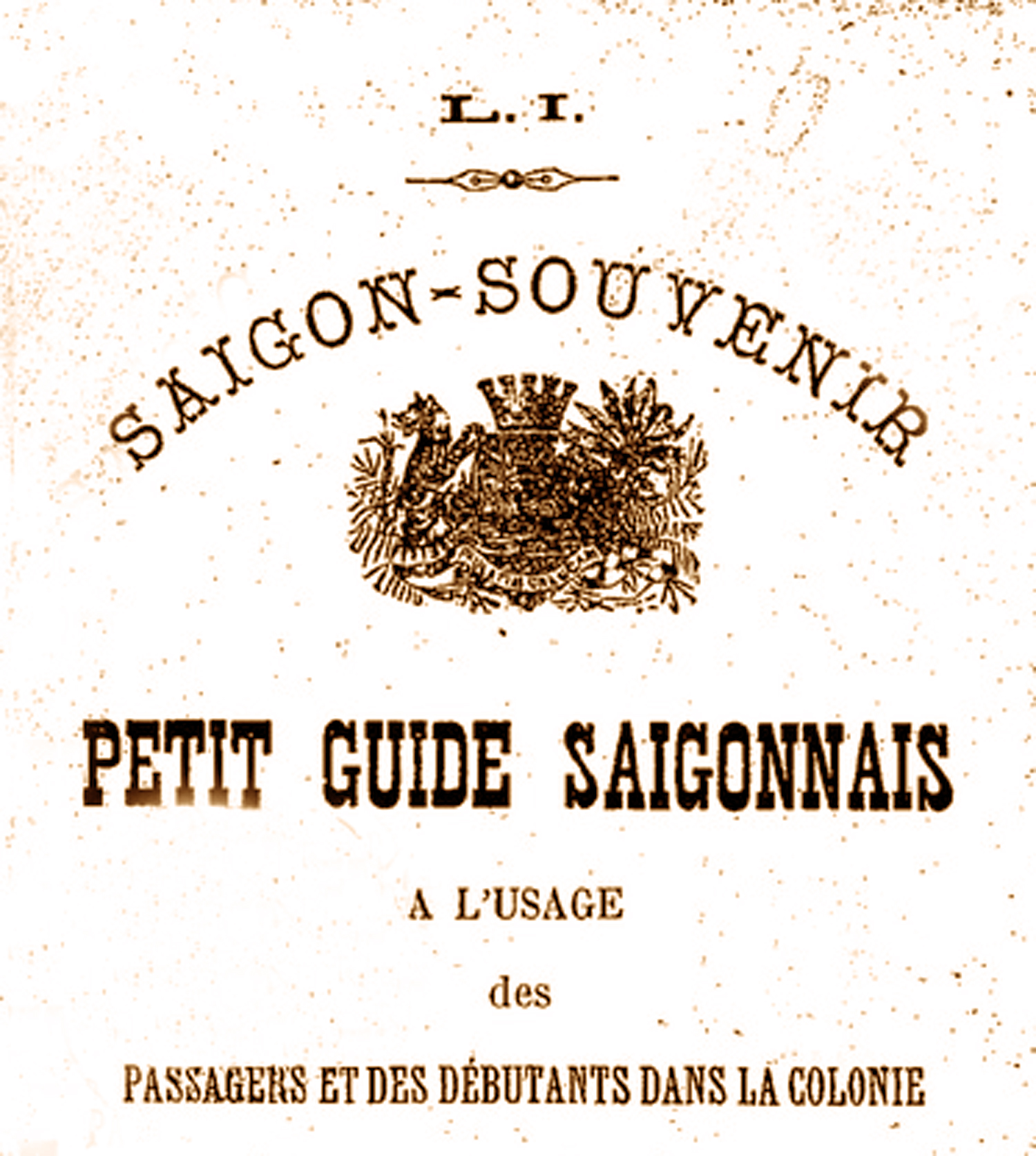
In 1906, an unknown writer using the pen name L. I. published a small brochure entitled Saïgon-Souvenir, petit guide saigonnais à l’usage des passagers des débutants dans la colonie for first-time visitors to the Cochinchina capital. Here is an English translation.
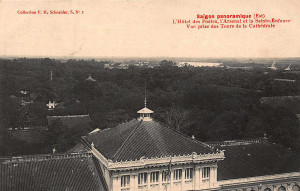
Saigon panorama (east): the Post Office, the Arsenal and the Sainte-Enfance, viewed from the towers of the Cathedral
Overall appearance – The city has the shape of an irregular trapezoid, with its sides formed by the Saigon river, the arroyo-Chinois (Bến Nghé creek), the Canal de ceinture (Belt Canal) and the arroyo de l’Avalanche (Thị Nghè creek).
The streets are straight, parallel, and intersect each other at right angles. Many boulevards cut through the city in all directions, connecting the spacious squares which are scattered throughout.
Saigon presents a cheerful aspect, jolly, spacious and elegant, while boasting the very best conditions of hygiene and safety.
The progress we have made in such a short time illustrates quite clearly the effort and energy which has been expended in order for Saigon to become recognised as the foremost city in Indo-China.
Indeed, if we think that in 1859, the date of the occupation by Admiral Rigault de Genouilly, Saigon was a dirty city filled with stinking swamps, its streets lined with unhealthy and badly-built huts, one can easily realise the importance of this change to the developing wealth of our capital of Cochinchina, the trade and industry of which continues to develop day by day.
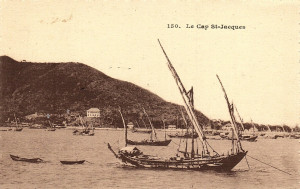
Cap Saint-Jacques (Vũng Tàu)
Arrival in Saigon – The author assumes that the reader of this brochure is arriving for the first time in the country. The many surprises for the new arrival include the wonderful baie des Cocotiers (Coconut Bay), Cap Saint-Jacques (Vũng Tàu) and the banks of the Saigon river. As we make our way up river, passing the rice fields and various plantations, we do not complain about the slow progress of the ship, which is partly due to the many twists and turns in the river, and partly due to the shifting sandbanks which the ship must carefully avoid.
Eventually in the distance we see the spires of the Saigon Cathedral, then gradually, the main monuments of the city and the rows of the large trees which line its boulevards and gardens.
As it makes its way towards its destination, the ship overtakes other merchant ships which are anchored along the shore and the city begins to reveal itself, scattered in all directions under the shade of thick vegetation.
A few brief orders are shouted, the whistle is blown repeatedly, and after a great deal of noise, the engine stops. The ship has docked at either the Messageries Maritimes or the Charner pier, the latter facing the main boulevard of that name.
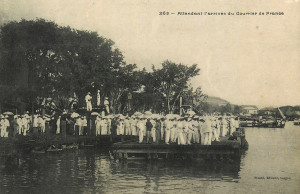
Saigon – awaiting the arrival of the courrier ship
A crowd of people, many stylishly dressed in white, awaits the arrival of friends, relatives or letters and parcels from France. This little spectacle touches your heart and makes you feel less homesick…
But the time for dreaming is over and life begins again. More shouting – from porters competing for luggage, hotel grooms handing out the calling cards of their hostelries, Chinese traders offering made-to-measure suits and shoes for almost nothing. All of this brings you back to reality.
Those whose ship has docked at the quai des Messageries Maritimes have a choice of transportation. If you want to save time, take a sampan and disembark near the boulevard Charner (Nguyễn Huệ). Alternatively, if you’re not in a hurry, hire a carriage or pousse-pousse and travel across the recently-built bridge which spans the arroyo-Chinois.
Those whose ship has docked at the Charner pier may very easily walk into town.
Visiting the city – According to Alexandre Dumas, there are three ways to tour a city: visiting the major monuments, visiting one neighbourhood after another, or, simplest of all, going from place to place visiting what lies immediately in front of you. We will tour Saigon in the latter way, believing it to be the most enjoyable and the most interesting.
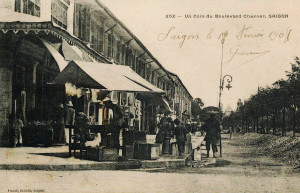
A corner of boulevard Charner, Saigon
We will begin on the quayside, facing the boulevard Charner, once a muddy and unhealthy arroyo. Later it was filled, the land was levelled, houses were built alongside it, and boulevard Charner was created.
The name of boulevard Charner comes from the great admiral who distinguished himself during the conquest of 1859. This boulevard leads to the recently-built Hôtel de Ville (City Hall), the architecture of which is a compound of different styles. The effect is original and pretty. Many electric arc lamps illuminate the boulevard, as well as the neighbouring streets of the city centre.
Note the imposing Hôtel des Douanes et Régies (Customs and Excise Department), located at the junction of boulevard Charner and the quayside.
Continuing along the river, we see proud warships at anchor; sampans and other small boats ply the water in all directions; and in some places, junks and other cargo ships load or unload their goods. The docks are crowded with people and cargo and the movement is incessant.
We pass in front of the rue Catinat (Đồng Khởi), which commences at the quai Francis-Garnier and leads up to the Cathedral.
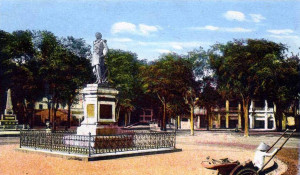
The statue of Admiral Rigault-de-Genouilly
We continue along the river, passing in front of the offices of the Chargeurs Réunis, the Messageries Fluviales, and various other transportation companies.
We arrive at the place Rigault-de-Genouilly (Mê Linh square), named after the famous French admiral to whom we owe the conquest of Cochinchina. On the square is a very beautiful statue of the admiral in full battle dress. This statue was installed in 1878 by national subscription. Next to it stands a high pyramid erected in memory of Doudart de Lagrée, the frigate commander who led the Mekong Expedition. This latter monument is surrounded by cannon which were confiscated from the enemy.
Many streets are arranged in a fan shape around the place Rigault-de-Genouilly, the most important being rue Paul Blanchy (Hai Bà Trưng). One of the longest streets in Saigon, it connects the river with an outer suburb, passing through much of the city.
Continuing through this square we reach the Naval stores and maintenance depots, the office of the Naval Commander, the Naval Artillery workshops, and then, on the boulevard Luro (Tôn Đức Thắng), the Naval Arsenal.
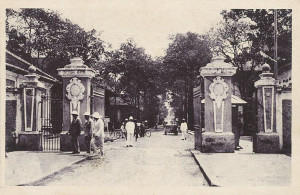
The main entrance to the Naval Arsenal
The Arsenal is undoubtedly the largest and busiest industrial installation in Saigon, staffed by large numbers of European and local civilian employees of all categories, not to mention the soldiers and sailors who are stationed here. Its dry dock permits our largest ships to be repaired easily.
Let’s now continue to the end of the boulevard Luro. After passing several charming villas and a number of religious institutions, we arrive at a vast square with manicured lawns, situated in front of the Colonial Infantry Barracks.
The Barracks were built on the site of an Annamite Citadel and are composed of large and airy iron pavilions, with surrounding vérandahs on each floor. The rooms are spacious and clean and the pathways connecting the pavilions are planted with trees; in short, the ensemble gives a very pleasing impression. Needless to say, the most rigorous standards of hygiene are observed here, offering our soldiers excellent conditions for safety and comfort.
All travellers are unanimous in saying that Saigon’s colonial barracks are the most beautiful in the world.
To further enhance the well-being of our military, a Cercle des Soldats et Marins (Soldiers’ and Sailors’ Club) has been installed right next to the barracks. A charming house serves as a reading room with a library of 1,500 volumes; a military theatre company gives evening performances at certain times in a special hall; and a bar sells refreshments at very low prices.
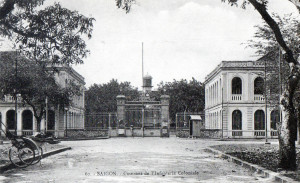
The Colonial Infantry Barracks
All of this offers our troops a range of diversions which they can enjoy without leaving the neighbourhood, and especially without incurring significant expenditure.
If one also mentions the games and sporting events of all kinds which are on offer in the garden of the Cercle, we may conclude rightly that the French soldier, when compared with the soldiers of other nations, is much better provided for in many respects.
Coming out of the barracks, our eyes are drawn to an area located close by, set amidst a forest of tall trees: it’s the Botanical and Zoological Gardens.
This institution, criss-crossed by wide and well-designed pathways, contains countless varieties of plants and shrubs, as well as cages containing animals of all kinds. Wild beasts represented here range from deer to elephants.
From time to time, the roar of a panther may be heard, but visitors have no need to worry and can continue their pleasant tour of the gardens. A large pavilion serves as an aviary where finches live in harmony with waders.
A forest kiosk showcases all of the species and varieties of wood in the country.
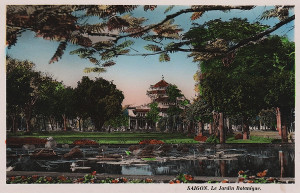
The Botanical and Zoological Gardens
The Botanical and Zoological Gardens is thus a true educational resource and visitors leave amazed and very satisfied, because they have learned so much about the fauna and flora of Indo-China.
The street in front of the Barracks is the boulevard Norodom (the name of the former king of Cambodia), and as we walk west along this street we find the Temple protestant (Protestant Church), the Conseil de guerre (Council of War), the Hôtel du Général de Division, and the Cercle militaire (Officers’ Mess).
Further along, as we pass behind the Cathedral, we reach the impressive statue in memory of Gambetta, erected by public subscription on 5 May 1889 under the title “Defender of colonial policy.” The statue depicts the great man standing proudly; the inclusion of a soldier and a sailor at his feet gives a martial flavour to the entire work.
At the end of boulevard Norodom, we arrive at the Palace of the Governor General, a princely and sumptuous residence set amidst vast gardens. This monument cost 12 million francs.
Returning to the Cathedral and making our way round to its front entrance, we find the statue of the Bishop of Adran, a peace-loving prelate and a true Frenchman.
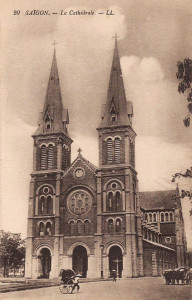
Saigon Cathedral
The Cathedral is a remarkable building of which the Saïgonnais are very proud. Thanks to its red brickwork, it bears a strong resemblance to the new church of the place des Abbesses in Paris. Built in 1877, the Cathedral cost 2.5 million francs.
A curious and original spectacle which deserves to be seen is the exit of the congregation from mass every Sunday morning. Here the pretty fashions of the European ladies, and the white suits worn without exception by all their men folk, mingle with the garish multicoloured outfits of the Indian women and the dark costumes of the Annamites.
On the place de la Cathédrale we find the Hôtel des Postes (Post Office), a magnificent building with a hall of grandiose dimensions; in short, a monument which honours the city.
Opposite the Cathedral, the rue Catinat leads down to the river. Catinat was the name of the first French corvette which bombarded the forts of Tourane in 1852. This street is the city’s oldest and largest, and it crosses Saigon at its centre point. As we travel down it, we find the Treasury, the Cadastre (Mapping Office), the Hôtel du Commandant de la la Brigade Coloniale, some administrative offices, and then shops, grand cafés and hotels.
In the middle of the rue Catinat, majestic and splendid, stands the Municipal Theatre, the pride of all the city’s inhabitants. Its elegant façade, tasteful interior decor and clever stage layout are a veritable marvel. Theatre troupes specialising in opera, comic opera, operetta and comedy give performances here four times a week, six months of year. The artists are engaged at great expense and their reputations are the best guarantee of success; performances are well attended by the entire European population, and passing travellers are also happy to spend their evenings here.
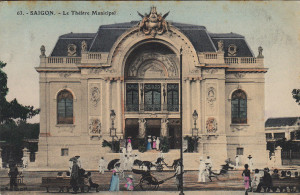
Saigon Municipal Theatre
Behind the Theatre is the electricity station. The main cafés are also located close to the Theatre; their appearance has nothing of the severity and coldness of the British cafés in Colombo or Singapore. Their rooms are spacious, pretty, filled with greenery and furnished with powerful electric fans; in short, they have an attractive appearance. Regular musical events are also organised in the large café terraces to cater for the European clientele.
Further down the street, beyond the Theatre, we find the houses of European traders and industrialists, large grocery stores run by Chinese merchants, and a wide variety of other shops, including basket weavers, tailors, shoemakers and watchmakers.
In the daytime, the animation on rue Catinat is somewhat limited, but towards the end of the day, the traffic increases as many people come here in their carriages to meet friends and acquaintances. It’s just like any major junction at 6pm on the boulevards of France.
At this time of day, the European ladies take advantage of the cooler temperatures to do their shopping, or simply to admire the stalls lit by electricity, the pretty appearance of which brings to mind the shops on the rue de Rivoli. Indeed, for our Saïgonnais, the rue Catinat is both the rue de Rivoli and the boulevard des Italiens.
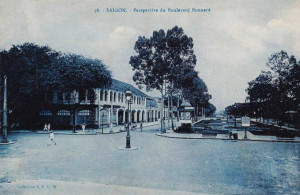
A view of boulevard Bonard
Another of the busiest places in the evenings is boulevard Bonard (Lê Lợi), which cuts across both the rue Catinat and the boulevard Charner. Lined with trees and decorated with beautiful lawns, it is a favourite spot for promenades.
A statue of Francis Garnier stands at the eastern end of this street, facing the Theatre. Nearby, at the intersection of the boulevards Bonard and Charner, a bandstand lit by electricity provides a forum for musicians of the Colonial Regiment and Musique de la Flotte every Wednesday night.
From the junction where the boulevard Bonard meets the rue Pellerin (Pasteur), we may visit the Palace of the Lieutenant Governor on the rue de Lagrandière (Lý Tự Trọng), a thoroughfare which leads back to the rue Catinat. Or we may continue up as far as the rue Taberd (Nguyễn Du), where we may find the Masonic Lodge, the local Société Philharmonique, and the Jardin de la Ville (City Park). The latter is beautifully laid out, with many trees and wide lawns intersected by neat pathways.
Continuing westward, we arrive at the camp des Mares, where both the barracks of the Annamite Rifle Regiment and a provisional camp of the Colonial Infantry are located. The camp des Mares is located on the Plain of the Tombs, which is entirely covered with ruined funerary monuments. The appearance of this place would be unpleasant, were it not for the bushes and leafy trees which dot the area.
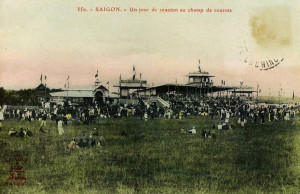
A race meeting at the Saigon Racecourse
Nearby, the beautiful Racecourse offers a cheerful note which compensates for the poor impression given by its dismal surroundings. Its stylish and well appointed spectator stands give it the look of a Parisian racecourse.
Returning via the rue Chasseloup-Laubat (Nguyễn Thị Minh Khai), we pass the northern perimeter of the Jardin de la Ville, which on this side contains the Vélodrome, and the facilities of the local sports society.
Going straight on, we pass the Water Tower and eventually arrive back at the Colonial Infantry Barracks,
The visitor will be struck by the splendour of the principal streets which cross the city, including notably the rues de Lagrandière, d’Espagne (Lê Thánh Tôn) and Paul Blanchy, all shaded by tall trees and lined with graceful villas set in manicured gardens full of exotic flowers and shrubs.
Visitors are recommended to visit the morning market on boulevard Charner. In fact the market, with its eight large halls, is insufficient to house the large number of merchants who do business here, and consequently many have set up shop in the surrounding streets. It would be superfluous to describe the market in detail; suffice it to say that it is both a native and a European market. In summary, a very interesting free spectacle.
Other places to tempt visitors include the Museum, which is always very interesting to visit. Nearby is the Military Hospital, with its pavilions similar in design to those of the Colonial Infantry Barracks.
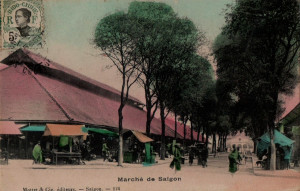
The second City Market (1870-1914)
Circles and societies – Many distractions are offered to Saïgonnais, thanks to the various societies which provide splendid entertainments: I will mention first of all the Société Indo-Chinoise de Secours Mutuels des anciens Militaires et Marins, which provides invaluable services; then I will mention the Cercle Colonial, the Cercle Militaire, the Société Philharmonique, the Société sportive, and the Société Hippique (Equine Society) which organises various popular events at its racecourse on the Plain of Tombs.
Surrounding areas – Thanks to the Tour d’Inspection, we can in a very short time discover the surrounding areas of the city. The Tour d’Inspection is a long standing tradition which involves following a specific route out of the city and back again. Every evening at around 6pm, after work is finished, most Saïgonnais feel the need to escape the sweltering heat by heading out of town for a breath of fresh air. Travelling in carriages, automobiles, pousse-pousse or even on horseback, they generally travel from Saigon to Gia-Dinh, a very pretty village located 5 kilometres from the city, with the return journey via the Botanical and Zoological Gardens. These roads are very pleasant and well maintained.
There are also other promenades on offer, such as that which takes visitors to Cholon, six kilometres from Saigon.
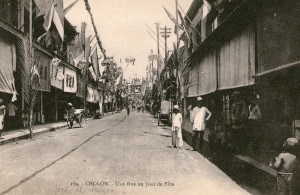
A Chợ Lớn street scene
Cholon – It would fill up a whole book to talk about this city, which has been called the most industrial and commercial city of all Indo-China. A visit to Cholon is essential for all newly arrived persons and its sights will surely remain etched on the memory. The means of transportation to get there are also quick, easy and inexpensive.
Bishop of Adran’s Tomb – It is also recommended to visit the tomb of the Bishop of Adran. Passing along rue Paul-Blanchy, the 3rd pont de l’Avalanche (Kiệu Bridge) and the route de Go-Vap, we then take the route de Tong-Kéou which crosses the canal de Ceinture (Belt Canal) and the Plain of Tombs. The tomb of the Bishop is classified as a national monument.
Population
The population of Saigon consists of a variety of nationalities. Here are the approximate figures:
French: 6,000
Other Europeans: 5,000
Annamites: 30,000
Cambodians: 150
Chinese: 13,000
Indians: 1.000
Japanese: 100
Malays: 500
Total: 55,750
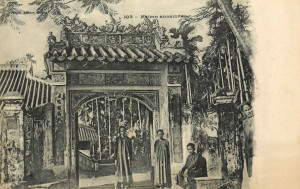
A Vietnamese house
The Annamites form several classes that are easily distinguished by the costume they wear.
Workers are generally coarsely dressed and not very stylish in their appearance; they walk barefoot.
Supervisors and clerical staff dress in white trousers and a dark shirt.
Finally there is the upper class, which includes retailers, attorneys and key employees of the government or large industries. These include alumni of the Écoles Chasseloup-Laubat and Taberd who have a higher education. Their female equivalent often dresses in European fashions.
Most Annamites carry an umbrella in any season, both for luxury and utility, for this item is necessary to protect against both the rain and the sun.
In general, the Chinese are in charge of trade and commerce. It is also noted that many small industries, such as tailoring, shoemaking and watchmaking on the rue Catinat, are the domain of the “sons of Heaven.”
Some Chinese own large merchant houses in Saigon and have very large interests in the market. Several of these are naturalised Frenchmen.
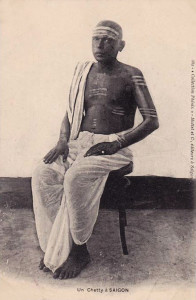
A member of the Chettyar (Tamil) community in Saigon
The Indians we encounter in the city are the subjects of Pondicherry. Educated and reliable, they occupy trusted employment in commerce, administration and the police force.
The Hindus, commonly named Malabars, are small traders. They do small trade and above all exchange money. Many tiny stalls around the city are held by them.
One kind of Indian, the Chettyars, are very oddly dressed. Wrapped in a white cloth, head shaved, forehead and cheeks decorated with ash, they lie in wait for the naïve European who needs money. They lend willingly, but only with strong guarantees and at a very high rate of interest.
The Malays keep properties and drive carriages. However, on the coast at Cap Saint-Jacques, many Malays are engaged in fishing and conduct a considerable trade.
Hygiene
The main hygiene requirements to be observed by Europeans, especially when they first arrive, are as follows:
Frequent and light meals, not too much meat; regular use of coffee in small doses, hot or cold.
Frozen drinks are beneficial for taste and hygiene, but their excessive use, as with all things for that matter, should be avoided.
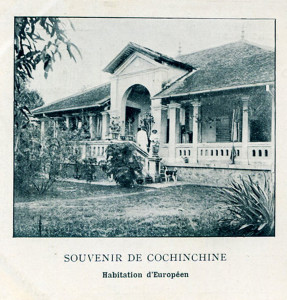
A European house in Saigon
The siesta is more harmful than useful, but it takes a tremendous will to abstain.
Clothing made from flannel or wool should be considered by all colonials.
These ideas are purely personal ones, but there are many other common sense precautions which are required for the preservation of health.
General rates (in piastres)
Carriages
Racecourse: 1st class – 0.25, 2nd class – 0.15
Return journey (15 minute stop): 1st class – 0.35, 2nd class – 0.20
First hour: 1st class – 0.50; 2nd class – 0.30
Subsequent hours: 1st class – 0.40; 2nd class – 0.25
Saigon to Cholon: 1st class – 0.70; 2nd class – 0.50
Saigon to Cholon return (1 hour stop): 1st class –1.30; 2nd class – 0.90
Tour d’Inspection, simple: 1st class – 0.90; 2nd class – 0.60
Grand Tour d’Inspection: 1st class – 1.50; 2nd class – 1.00
Pousse-pousse
Racecourse: 0.10
First hour: 0 25
Subsequent hours: 0.20
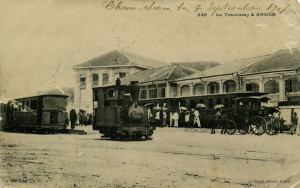
The steam tramway terminus on boulevard Charner
Saigon-Cholon Steam Tramway
Saigon to Cholon: 1st class – 0.10; 2nd class – 0.06; 3rd class – 0.03
Other items
Stamps, postcards, letter cards and stamped envelopes are sold at the Hôtel des Postes and in branch post offices at the same price as in France (giving to the piastre a constant value of 2.50 francs).
We close these pages without wanting to dwell on anything at length or to stray outside the framework outlined. We just wanted to give, simply and in a succinct way, some information about the city and its surroundings. We hope that this brochure will be received benevolently by the public. Soon we plan to publish a more substantial guide giving exact details of the commerce, industry, agriculture, etc, of the country.
Hoping in this way to be helpful to all new arrivals in the colony, the author very modestly permits himself to dedicate this pamphlet to all its readers.
L. I., June 1906
Tim Doling is the author of the guidebook Exploring Saigon-Chợ Lớn – Vanishing heritage of Hồ Chí Minh City (Nhà Xuất Bản Thế Giới, Hà Nội, 2019)
A full index of all Tim’s blog articles since November 2013 is now available here.
Join the Facebook group pages Saigon-Chợ Lớn Then & Now to see historic photographs juxtaposed with new ones taken in the same locations, and Đài Quan sát Di sản Sài Gòn – Saigon Heritage Observatory for up-to-date information on conservation issues in Saigon and Chợ Lớn.

